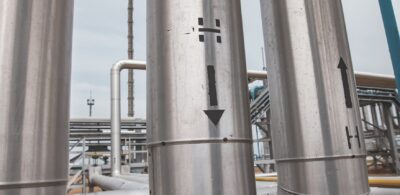Update on Australia’s Hydrogen Guarantee of Origin and Certification Scheme
08 March 2022
On Friday 28 January 2022 the Suiso Frontier, the world’s first liquefied hydrogen ship, departed the Port of Hastings, Australia with an end destination of Kobe, Japan. The ship was loaded with hydrogen supplied from the Hydrogen Energy Supply Chain (HESC) pilot project in Victoria, heralding a significant moment for Australia’s emerging hydrogen sector as it embodied the first export of Australian produced hydrogen. It also represented the first shipment of liquid hydrogen globally.
With the first shipment of liquefied hydrogen having taken place, it is an opportune time to revisit the status of Australia’s Hydrogen Guarantee of Origin and Certification Scheme (GO Scheme), which, as we have previously discussed also in terms of hydrogen regulation in Australia. It is essential for providing Australia’s hydrogen customers with assurance that the product is what it is and does what it says it does.
Industry trials
On 10 December 2021, the Australian Government Department of Industry, Science, Energy and Resources (DISER) announced the commencement of voluntary industry trials of Australia’s GO Scheme. The trials are being administered by the Clean Energy Regulator (CER) in collaboration with DISER. Phase 1 of the trials will begin in March 2022, with phase 2 to occur from August 2022 to June 2023.
The purpose of the trials is to settle the specifications for the GO Scheme, so that it can be implemented in a manner that will ensure ease of operational compliance as well as international recognition.
Basis for industry trials
The framework for the industry trials is being guided by feedback DISER received last year on its discussion paper (released in June 2021) and the work of the International Partnership for Hydrogen and Fuel Cells in the Economy (IPHE), including the working paper released in October last year.[1] Our comments on the questions raised by DISER in its discussion paper are here.
Key findings from DISER’s consultation are that a majority of respondents support:
- a ‘well-to-gate’ system boundary for the first iteration of the GO Scheme, which accounts for upstream emissions (including those associated with raw material supply such as the extraction of fossil fuels, transport, storage and pre-processing) and emissions from hydrogen production and processing in tracking the emissions produced by the hydrogen product;
- leveraging ISO standards and the Greenhouse Gas Protocol as carbon accounting methodologies;
- an internationally-aligned approach for calculating scope 1 and upstream emissions;
- a market-based approach for the calculation of scope 2 emissions;
- the GO Scheme to be implemented as a certificate scheme; and
- the GO Scheme to be administered by the Australian Government and, more specifically, the CER.
It is apparent from the consultation results that the respondents’ views lacked consensus when it came to:
- whether project owners can use carbon offsets, such as Australian Carbon Credit Units (ACCUs), to reduce the emissions from hydrogen production (i.e. carbon neutral hydrogen) and thereby secure a “greener” certification;
- the establishment of a guarantee of origin certificate for renewable electricity to replace large-scale generation certificates;
- allocating part of the gross emissions to co-products produced as part of the production pathway, where those co-products are on-sold (e.g. for an electrolysis pathway, the gross emissions could be allocated to hydrogen as the main product and oxygen as a co-product); and
- the role, if any, that carbon capture, use and storage (CCUS) was to have in the GO Scheme.
Significance of the trials
The lack of consensus on many of the key design aspects of the GO Scheme demonstrates the importance of the upcoming industry trials. These trials will be used to test and refine the methodologies of the GO Scheme and outcomes are likely to influence the type of hydrogen projects which will succeed in Australia.
Take for example the HESC project, a world-first circa A$500 million pilot project partly funded by the Australian Federal Government (A$57.5 million) and Victorian Government (A$50 million committed so far).[2] The project relies on the gasification of Victorian brown coal for hydrogen production, a method many consider controversial due to its continuing support for the coal sector. To offset the emissions created by the gasification of coal, the project is utilising carbon credits during the pilot phase and, if the project proceeds to the commercial stage, it intends to utilise CCUS to store the emissions in the Gippsland Basin. The CCUS component of the project is known as the CarbonNet Project and has received significant regulatory support.
While CCUS is recognised in the GO Scheme due to the Australian Government’s present technology neutral stance, use of ACCUs from all registered Emissions Reduction Fund projects (not just CCUS projects) and other carbon offsets is a matter of industry contention. The IPHE made clear in its working paper that the exclusion of offsets is recommended. If following the trial the preference is for the GO Scheme to align with international standards, the hydrogen which is produced from projects using offsets is likely to have a high emission rating which consumers may not be willing to purchase, thereby impacting the viability of the project as a whole.
The significance of the trials, therefore, cannot be understated and it will be important for stakeholders to observe how the GO Scheme will develop following it.
Industry led green hydrogen initiatives
While the Australian Government’s GO Scheme is technology neutral, there have been industry-led initiatives to develop certification schemes specifically for green hydrogen.
The recently-formed Green Hydrogen Organisation (also known as “GH2”) has resolved to create and release a green hydrogen standard (GH2 Standard) by 17 May 2022.
The GH2 Standard proposes a system boundary which extends from upstream emissions with water, energy and electricity production through to downstream emissions from hydrogen transportation and use. This contrasts with the Australian Government’s proposed ‘well-to-gate’ boundary for the GO Scheme, albeit DISER has flagged that Australia’s GO Scheme may be extended in the future to include emissions from hydrogen conversion, transport and storage.
Another industry-led initiative is the Smart Energy Council’s Zero Carbon Certification Scheme which has “partners” comprising of industry participants and the governments of Queensland, Victoria, Western Australia and the ACT. The Zero Carbon Certification Scheme assesses the embedded carbon in renewable hydrogen, green ammonia and green metals as well as the origin of the products. Similar to DISER’s GO Scheme, the Zero Carbon Certification Scheme intends to adopt a well-to-gate system boundary. However the inclusion, in particular, of green ammonia is a key point of difference to DISER’s GO Scheme, which currently does not consider emissions from the conversion of hydrogen to ammonia or other forms such as liquid hydrogen or liquid organic hydrogen carriers (such as methylcyclohexane). The Smart Energy Council has so far certified one pilot project under the Zero Carbon Certification Scheme, being ActewAGL’s hydrogen refuelling station in Canberra. The organisation is also currently undertaking a pre-certification assessment of Yara’s planned green ammonia project in the Pilbara, Western Australia.
Although DISER’s consultation results suggest that industry has a preference for a government-led GO Scheme, it will be interesting to see how these industry-led initiatives evolve and what impact they have on the final design for the Australian GO Scheme.
Final thoughts
The commencement of industry trials for Australia’s GO Scheme is a significant next step in actioning the National Hydrogen Strategy. The results of the trials, along with future work by the IPHE, will be important for the final design of the GO Scheme. It will also be important for stakeholders to observe how industry-led GO Scheme initiatives for green hydrogen develop alongside the Australian Government’s technology neutral scheme.
[1] International Partnership for Hydrogen and Fuel Cells in the Economy (IPHE), ‘Methodology for Determining the Greenhouse Gas Emissions Associated With the Production of Hydrogen’ (4 October 2021).
[2] The Honourable Angus Taylor MP, ‘Hydrogen industry marks milestone with first shipment of liquid hydrogen to Japan’ (Media Release, 21 January 2022); HESC, ‘FAQs’ (Web Page).
Authors

Partner
Tags
This publication is introductory in nature. Its content is current at the date of publication. It does not constitute legal advice and should not be relied upon as such. You should always obtain legal advice based on your specific circumstances before taking any action relating to matters covered by this publication. Some information may have been obtained from external sources, and we cannot guarantee the accuracy or currency of any such information.



